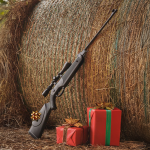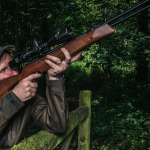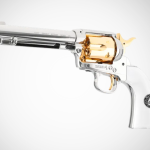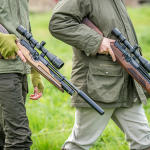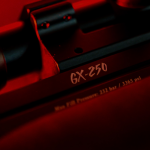We’ve finally put together Bristol Airguns’ comprehensive guide to Pre-Charged Pneumatic (PCP) air rifles! Whether you’re a complete beginner or a seasoned shooter, this guide aims to answer your questions and provide valuable insights into the world of PCP air rifles.
Safety First
Safety is paramount when handling any type of firearm, including airguns. Here are essential safety tips:
- Always treat your airgun as if it were loaded.
- Keep your finger off the trigger until you are ready to shoot.
- Never point your airgun at anything you do not intend to shoot.
- Keep the safety on until you are ready to fire.
- Be aware of your surroundings and ensure that you have a safe backstop.
- Do not play around with airguns; they are not toys.
- Remember, you represent the shooting community, so act responsibly to avoid stricter regulations.
What is a PCP Air Rifle?
PCP stands for Pre-Charged Pneumatic. These airguns use compressed air to propel pellets. Here’s a brief overview of different propulsion methods:
- Spring-Piston Airguns: Use a spring mechanism, similar to a bicycle pump, to compress air for each shot. These provide one shot per action.
- CO2 Airguns: Use CO2 canisters, offering multiple shots per canister but can be costly and provide limited shots, especially with larger calibers or higher velocities.
- PCP Airguns: Utilize an onboard air reservoir filled with compressed air, offering multiple shots per fill, more power, and higher consistency than CO2 and spring-piston airguns.
Charging Methods
PCP airguns require filling the onboard reservoir with compressed air. There are three main charging methods:
- Hand Pumps:
- Cost: £30-£180.
- Effort-intensive; use your body weight to pump air into the reservoir.
- Connect the pump, close the bleed valve, and pump until the desired pressure is reached. Release the air in the connecting pipe before disconnecting.
- Diver’s Tanks:
- Cost: £100-£300.
- Require refilling at dive shops (around £5 per fill).
- Provide multiple gun fills depending on tank and gun sizes. Connect the tank, open the main valve slowly, fill to the desired pressure, and then release excess air in the pipe.
- Compressors:
- Cost: £160-£2500.
- Ideal for frequent or high-power shooters.
- Can fill guns directly or charge diver’s tanks. Connect the compressor, close the bleed valve, start filling, and monitor the pressure gauge.
Why Choose a PCP?
PCP airguns offer several advantages over spring-piston and CO2 airguns:
- Higher Shot Count: More shots per fill compared to CO2 and spring-piston airguns.
- Consistency and Accuracy: No moving springs reduce recoil, resulting in better accuracy.
- Power: Can be used for a variety of shooting activities from plinking to pest control, with adjustable power levels in some models.
Power Levels
Different countries have different regulations for airgun power:
- UK: Rifles under 12 ft-lbs and pistols under 6 ft-lbs do not require a license.
- Higher Power Guns: Available in some countries, particularly the USA, allowing for more significant pest control and longer-range shooting.
Types of PCP Airguns
There are various types of PCP airguns to suit different preferences and purposes:
- Traditional Rifles: Classic design, often with wooden stocks.
- Bullpup Designs: Compact and balanced, ideal for tight spaces.
- Synthetic Stocks: Durable and weather-resistant.
- Electronic Guns: Advanced features like electronic triggers and power adjustments.
Ammunition
PCP airguns primarily use lead pellets, available in various calibers:
- .177 (4.5mm): High velocity, flatter trajectory, ideal for target shooting.
- .22 (5.5mm): Higher stopping power, suitable for pest control.
- .20 and .25: Offer a balance between the two, with growing popularity.
Sighting and Scopes
Most PCP rifles do not come with sights and require external sighting aids:
- Rails: Mount scopes using Weaver, Picatinny, or Dovetail rails.
- Scopes: Choose based on magnification needs; hunters prefer lower magnification, while target shooters may opt for higher magnification.
- Focus and Parallax Adjustment: Important for accuracy, especially at varying distances.
Single or Multi-Shot
PCP airguns offer options for both single-shot and magazine-fed multi-shot configurations:
- Magazines: Allow for quick reloading, available in various capacities.
- Single-Shot Trays: Preferred by some for precision, as each pellet is loaded manually.
Barrels
- Rifled Barrels: Spin the projectile for stability and accuracy.
- Twist Rates: Vary to match specific pellet or slug types.
Silencers
- Silencers/Moderators: Reduce the noise of the shot. Many PCPs come with threaded barrels for aftermarket silencers.
Accessories
A wide range of accessories is available for PCP airguns, including:
- Bipods and Rests: For stability.
- Cases and Bags: For transport and protection.
- Cleaning Kits: Essential for maintaining accuracy and longevity.
By understanding these basics, you can make an informed decision on choosing and using PCP airguns. Stay safe and enjoy your shooting experience!

